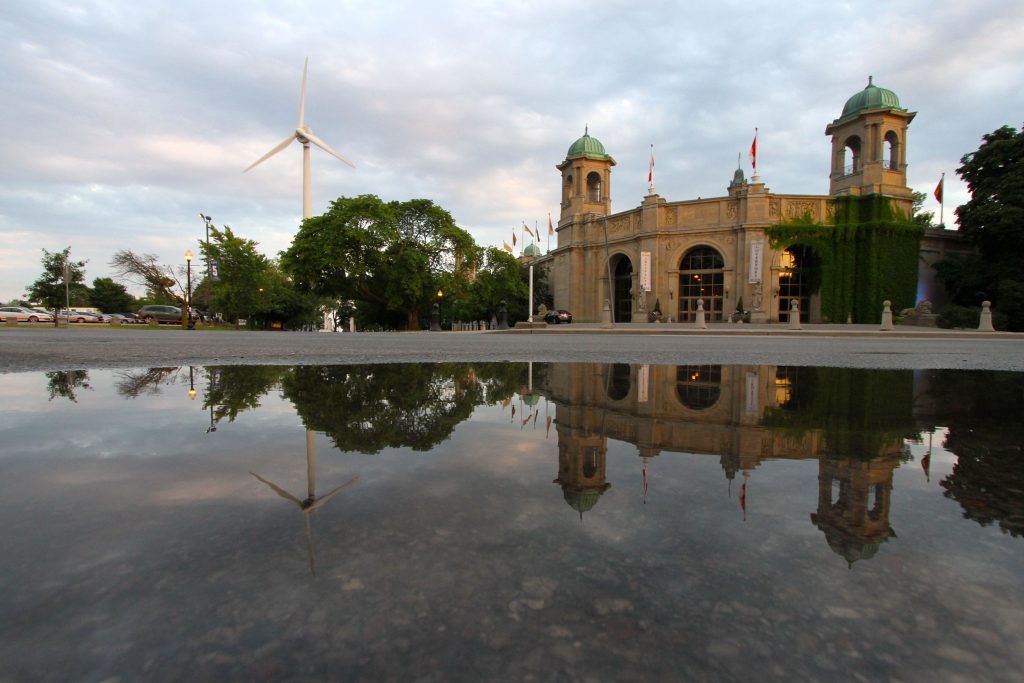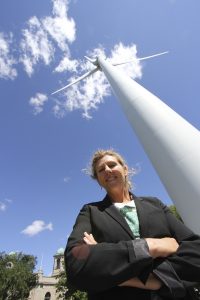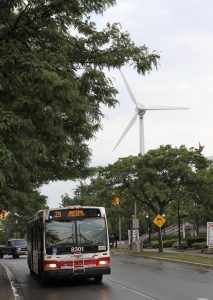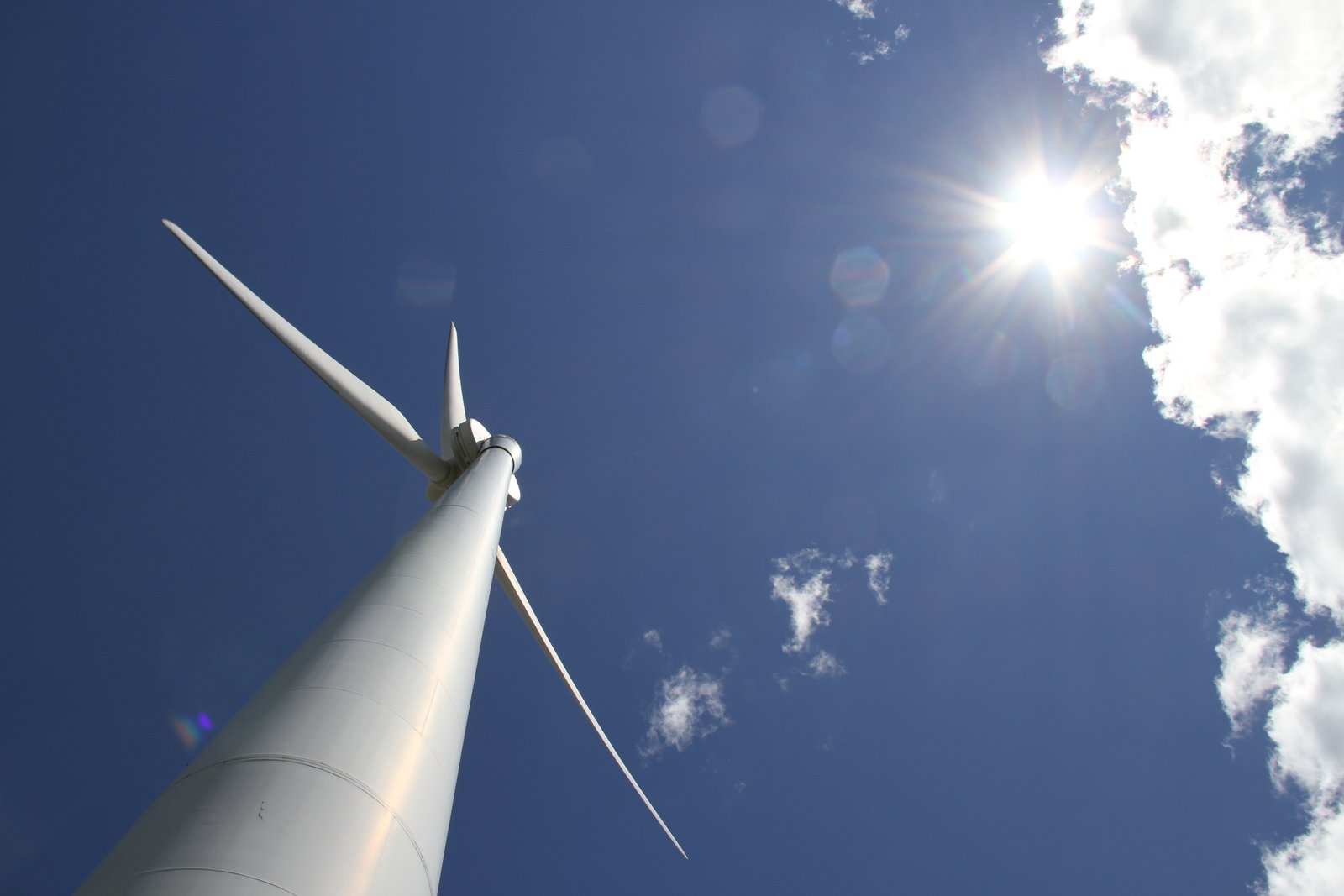By David Dodge and Duncan Kinney
Mathematician, meteorologist and chaos theory pioneer Edward Lorenz was the man behind the butterfly effect. The simple, appealing idea embedded in the analogy that if a distant butterfly flaps its wings a few weeks later you might have a hurricane on your doorstep.
Twelve years ago the Toronto Renewable Energy Cooperative formed with a simple idea – build a highly visible urban wind turbine – and it ended with the most robust renewable energy regime in North America.

Toronto wind turbine on the water front
Deb Doncaster is currently the executive director of the Community Power Fund and former executive director of the Ontario Sustainable Energy Association. She was involved with TREC almost from the beginning.

Deb Doncaster was a former staff and board member of the Toronto Renewable Energy Cooperative and has been involved in Ontario’s renewable energy scene ever since this project.
“I don’t know that there was a big vision beyond bringing renewable energy technologies into the Ontario marketplace and allowing for diverse forms of ownership. At that point in time we hadn’t envisioned a feed-in tariff program, we hadn’t envisioned a Green Energy Act for Ontario, it was really let’s just introduce windmills and let’s introduce the notion of community ownership.”
The original idea was simple. Get a community-owned wind turbine up and generating power right on the waterfront of Lake Ontario in Toronto.
It wasn’t easy. Multiple sites were considered and not everyone in the community was excited about the project, but in 2002 Exhibition Place was identified as a viable location. Within four months the project, dubbed WindShare, had 427 pioneer members who had invested an average amount of $2,000 each in support of the turbine. On the second day of construction, WindShare membership rolls were full and the $800,000 capital investment target had been reached.
At the time there was less than one megawatt of wind energy capacity in Ontario. Today, Ontario has 1,969 megawatts of wind energy capacity – the most of any province in Canada.
It wasn’t just the first urban wind turbine in north America it was also the first for-profit cooperatively owned wind turbine in Canada. It was a model that the Peace Energy Cooperative later followed with the development of Bear Mountain Wind Park in northern British Columbia.
But was the $1.8 million dollar price tag worth it for TREC?
Renewable, Sustainable Growth
Judith Lipp is the no-nonsense executive director of TREC and one of the key people in the renewable energy scene in Ontario. From her perspective the Ex Place wind turbine was definitely worth it.

Judith Lipp is the executive director of TREC. She says that the original behind TREC wanted this urban wind turbine to function as an icon for the green energy movement.
“It was built at a time when wind energy was not really on anyone’s radar in Canada. The folks that formed TREC really wanted a site that would act as a demonstration, an icon if you will, for the green energy movement.”
Quite the icon. Visible from Lakeshore Boulevard and the always-busy Gardiner Expressway, hundreds of thousands of commuters see the turbine every day. When I stopped for some refreshments at a Queen Street hotel there was the turbine visible through the window more than a kilomtere away. (see photo essay)
The Exhibition Place wind turbine doubles as the linchpin of a large-scale education program. In the 2008/2009 school year TREC reached more than 4,000 grade 5, 7 and 9 students.
TREC
and Windshare were also the starting point for an emerging renewable energy movement. People who were involved moved on and created many more community-minded renewable energy initiatives.
- The Ontario Sustainable Energy Association, an organization formed to implement community sustainable energy projects across Ontario;
- The Community Power Fund – a financing organization establishedin 2007 to support owned renewable energy projects;
- SolarShare – A not for profit co-operative corporation with the express goal of growing community-based solar electricity generation in Ontario by engaging residents and investors in projects that offer tangible financial, social, and environmental returns;
- And ultimately the Green Energy Act, Ontario’s German-inspired feed-in tariff was passed leading to thousands of wind, solar, hydro and biofuels projects being developed in Ontario.

The Toronto wind turbine produces about one million kilowatt hours of electricity per year, but it’s value is probably much higher as an educational tool promoting renewable energy in Canada’s most populous city. Photo David Dodge, Green Energy Futures
According to Paul Gipe the feed-in-tariff policy has been responsible for most of the renewable energy developed in the world. For more on feed-in tariffs check out our episode featuring author Chris Turner and Paul Gipe’s website.
A feed-in tariff is an obligation built into the price of electricity so that the price of everyone’s electricity goes up a little bit while renewable energy gets established.
Explosive Renewable Energy Growth
In December of 2012 the Exhibition Place wind turbine will celebrate its 10th year of operation. In those ten years renewable energy growth has exploded in Ontario.
Since the passing of the Green Energy Act in February of 2009 the Ontario Power Authority (OPA) reports indicate almost 50,000 Ontario individuals, businesses and community and aboriginal groups have applied for FIT contracts to build renewable energy projects.
The Ontario Power Authority has entered into more than 13,000 microFIT project contracts and almost 2,000 FIT contracts to build 4,662 megawatts of renewable power projects. These solar, wind, bioenergy and hydro projects are big and small and sprinkled all over Ontario. (see OPA Progress Report)

Tyler Hamilton
Tyler Hamilton is the editor of Corporate Knights magazine and a columnist with the Toronto Star on the renewable energy beat.

A Torontonian takes her dog for a walk near the Exhbition Place Turbine, North America’s first urban wind turbine.
“If you drive around the province you see the evidence of the energy strategy in front of you. You see farmers that have solar power, ground-mount solar systems on their land, you see wind turbines and wind farms everywhere. It’s clearly visible compared to five years ago. So from that perspective there’s been a lot of progress in a short amount of time,” says Hamilton.
Change that comes this fast is not without controversy, but what’s often lost in the hyperbole is the simple fact that Ontario has engaged thousands of citizens as well as small, medium and large businesses in building out the next generation of energy infrastructure.
Walking with Deb Doncaster in the shadow of North America’s first urban wind turbine it seems pretty clear this project that former Mayor David Miller once took to Copenhagen as a symbol of a solution to climate change has settled in as a striking element of the brand of Canada’s largest city.
[flickrshow:72157630450197272,width=625]
